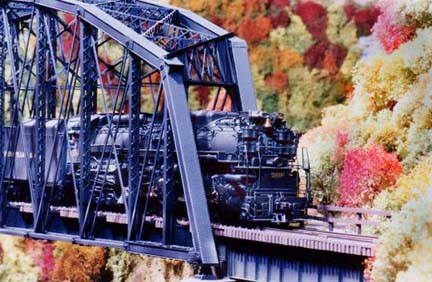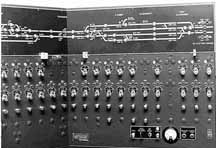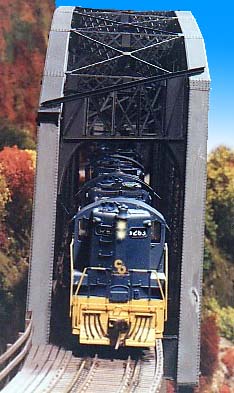|
|
|
|
|
|||||||||||
| Jim EuDaly is a well known C&O modeler, rail fan and author. He has a large O scale C&O layout that is spectacular in several respects including scratchbuilt engines, beautiful structures, scenery and an operational CTC machine. He wrote about his view of operations on the C&O. Updated with Photos by Jim EuDaly. | |||||||||||
| by Jim EuDaly
I suggest that the best way to have a layout support prototype operations is to copy the prototype track layouts as accurately as possible. I did that when I designed my layout many years ago and only after I had built it did I begin to learn how the railroad operated. Fortunately, my layout will run an accurate schedule with appropriate movements both in Hinton Yard and on the mainline. As to questions regarding signalling practices, I believe that understanding the operating practices will help a great deal. This is my understanding of train movements on the Alleghnay Sub. I'm using passenger train schedules for August 1945 and Time Freight schedules for January 1949. All coal drags, pusher movements and empty hopper trains were extras. Empty hopper trains could be called out of Clifton Forge at any time and the Hinton Yardmaster would deal with them when they showed up. Eastbound coal trains out of Hinton were handled differently. Once each day the Chief Dispatcher at Clifton Forge sent Hinton a set of call time windows during which coal trains could be called. These windows were based on anticipated times of passenger trains and time freights. They were based on the principle that coal trains could run to Alleghany and get in the clear on the siding before any scheduled trains caught up with them. Any time the Hinton yardmaster had a coal train ready during a window he could call it. |
 |
||||||||||
 |
|||||||||||
| The goal was to get the trains called as early in the window as possible so they had the maximum time to deal with nay problems without delaying scheduled trains. There was very little traffic running on the "wrong" main. I visited WS Cabin in the late '50's or early '60's and there was not a single train on the sheet that had run against the current of traffic.
Coal trains at Hinton could not be called closer together than 1.5 hours. This was to prevent two coal trains from being at Alleghany at the same time. In the days of steam all coal trains and all eastbound manifests stopped at Alleghany to turn up retainers, which took 20-30 minutes. Another item to slow down our operations. Signalling practices evolved over the years but the following is my understanding of the customs when CTC machines for Alleghany and New River were both at Hinton: The CTC machines controlled only the switches and signals at what Conrail now calls "control points." Between these points traffic was controlled by Automatic Block Signal (ABS). It is true that some sections of the railroad had signals (ABS) for one direction while other stretches had ABS both directions on both tracks. Signals not controlled by the dispatcher were not on the CTC machine but block lights on the model board showed the dispatcher that the track was occupied or clear. When a dispatcher cleared a train into a section controlled by ABS which was single track, whether signalled only one direction or both directions, two things happened: 1. the signal (controlled) opposing the movement at the other end of the single track would not clear, and 2. all ABS signals opposing the movement would "tumble down" to stop. The kicker was that trains following the first train moving against the current of traffic had no signal protection against the train ahead of them if there were no signals for that movement. I think that explains the use of Rule D-251. I have a friend, who is a signal engineer for Harmon Industries here in the KC area, models B&O in HO scale. More germanely, he was an engineer in the signal department for Chessie and CSX, living for 10 years in Huntington and was the Chief Engineer of the Signal and Communications Department for CSX in Jax before resigning and coming to Harmon Industries. My understanding of CTC practices for my railroad largely came from his advice. I'm using a CTC machine which covers the entire railroad except for Hinton Yard Limits. If you're interested in the era when the local interlockings were still open, here is his description of Rule D-251. Because we are running on a fast clock on our layouts there are two railroad activities which don't scale down very effectively; One is the writing of train orders. We can't write 4 times or 6 times as fast as a railroad operator so writing orders takes more time by the factor of our clock ratio. The above "stuff" is the way I run my railroad on the Alleghany Sub. The New River sub is another whole story. |
|||||||||||
| Not a prototype photo, but a shot of Jim EuDaly's CTC machine. | |||||||||||
 |
|||||||||||
|
|
|||||||||||